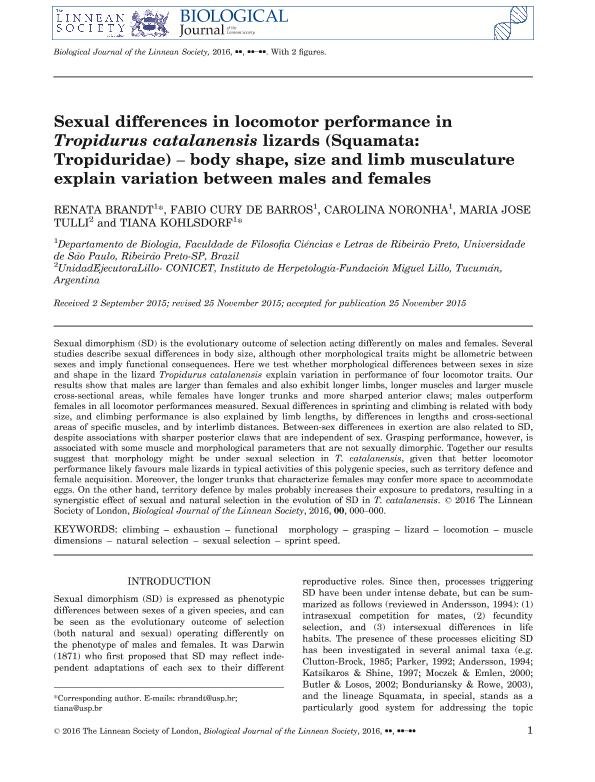Mostrar el registro sencillo del ítem
dc.contributor.author
Brandt, Renata
dc.contributor.author
Cury de Barros, Fabio
dc.contributor.author
Noronha, Carolina
dc.contributor.author
Tulli, María José

dc.contributor.author
Kohlsdorf, Tiana
dc.date.available
2017-02-10T17:28:31Z
dc.date.issued
2015-12
dc.identifier.citation
Brandt, Renata; Cury de Barros, Fabio; Noronha, Carolina; Tulli, María José; Kohlsdorf, Tiana; Sexual differences in locomotor performance in Tropidurus catalanensis lizards (Squamata: Tropiduridae) – body shape, size and limb musculature explain variation between males and females; Wiley; Biological Journal Of The Linnean Society; 118; 3; 12-2015; 598–609
dc.identifier.issn
0024-4066
dc.identifier.uri
http://hdl.handle.net/11336/12843
dc.description.abstract
Sexual dimorphism (SD) is the evolutionary outcome of selection acting differently on males and females. Several studies describe sexual differences in body size, although other morphological traits might be allometric between sexes and imply functional consequences. Here we test whether morphological differences between sexes in size and shape in the lizard Tropidurus catalanensis explain variation in performance of four locomotor traits. Our results show that males are larger than females and also exhibit longer limbs, longer muscles and larger muscle cross-sectional areas, while females have longer trunks and more sharped anterior claws; males outperform females in all locomotor performances measured. Sexual differences in sprinting and climbing is related with body size, and climbing performance is also explained by limb lengths, by differences in lengths and cross-sectional areas of specific muscles, and by interlimb distances. Between-sex differences in exertion are also related to SD, despite associations with sharper posterior claws that are independent of sex. Grasping performance, however, is associated with some muscle and morphological parameters that are not sexually dimorphic. Together our results suggest that morphology might be under sexual selection in T. catalanensis, given that better locomotor performance likely favours male lizards in typical activities of this polygenic species, such as territory defence and female acquisition. Moreover, the longer trunks that characterize females may confer more space to accommodate eggs. On the other hand, territory defence by males probably increases their exposure to predators, resulting in a synergistic effect of sexual and natural selection in the evolution of SD in T. catalanensis.
dc.format
application/pdf
dc.language.iso
eng
dc.publisher
Wiley

dc.rights
info:eu-repo/semantics/openAccess
dc.rights.uri
https://creativecommons.org/licenses/by-nc-sa/2.5/ar/
dc.subject
Climbing
dc.subject
Exhaustion
dc.subject
Functional Morphology
dc.subject
Grasping
dc.subject
Lizard
dc.subject
Locomotion
dc.subject
Muscle Dimensions
dc.subject
Natural Selection
dc.subject
Sexual Selection
dc.subject
Sprint Speed
dc.subject.classification
Otros Tópicos Biológicos

dc.subject.classification
Ciencias Biológicas

dc.subject.classification
CIENCIAS NATURALES Y EXACTAS

dc.title
Sexual differences in locomotor performance in Tropidurus catalanensis lizards (Squamata: Tropiduridae) – body shape, size and limb musculature explain variation between males and females
dc.type
info:eu-repo/semantics/article
dc.type
info:ar-repo/semantics/artículo
dc.type
info:eu-repo/semantics/publishedVersion
dc.date.updated
2017-02-09T18:24:36Z
dc.journal.volume
118
dc.journal.number
3
dc.journal.pagination
598–609
dc.journal.pais
Estados Unidos

dc.journal.ciudad
Hoboken
dc.description.fil
Fil: Brandt, Renata. Universidade de Sao Paulo; Brasil
dc.description.fil
Fil: Cury de Barros, Fabio. Universidade de Sao Paulo; Brasil
dc.description.fil
Fil: Noronha, Carolina. Universidade de Sao Paulo; Brasil
dc.description.fil
Fil: Tulli, María José. Consejo Nacional de Investigaciones Científico y Técnicas. Centro Científico Tecnológico Tucumán. Unidad Ejecutora Lillo; Argentina. Fundación Miguel Lillo. Dirección de Zoología. Instituto de Herpetología; Argentina
dc.description.fil
Fil: Kohlsdorf, Tiana. Universidade de Sao Paulo; Brasil
dc.journal.title
Biological Journal Of The Linnean Society

dc.relation.alternativeid
info:eu-repo/semantics/altIdentifier/doi/http://dx.doi.org/10.1111/bij.12760
dc.relation.alternativeid
info:eu-repo/semantics/altIdentifier/url/http://onlinelibrary.wiley.com/doi/10.1111/bij.12760/abstract
Archivos asociados
